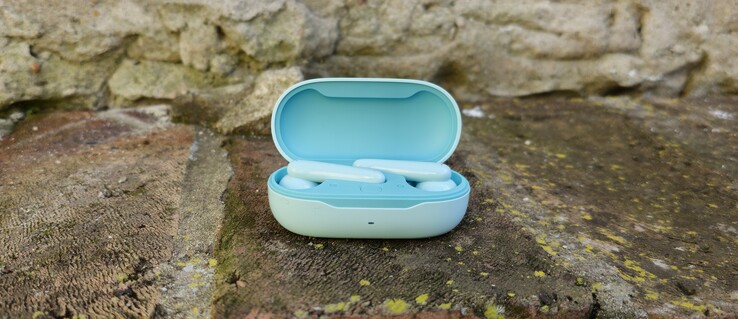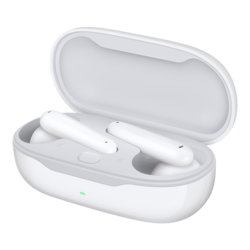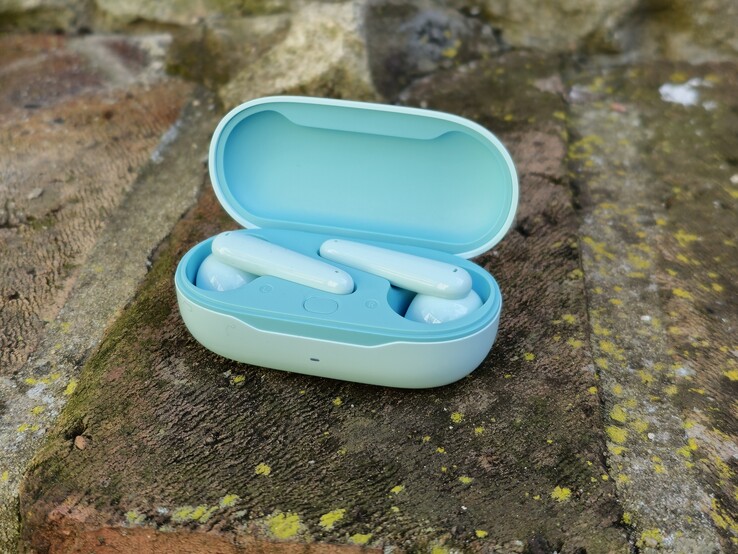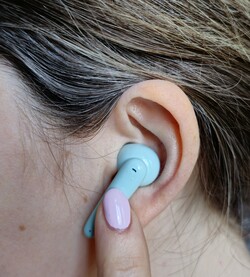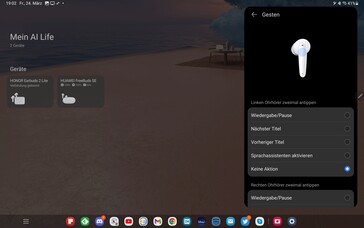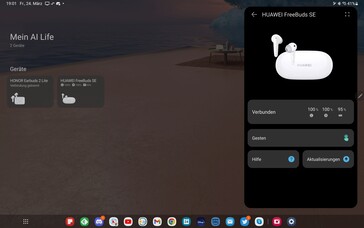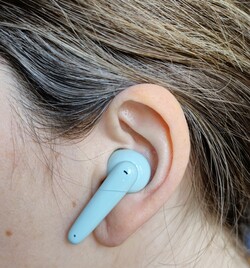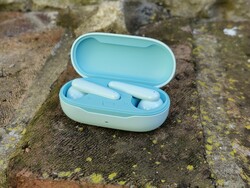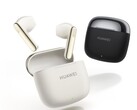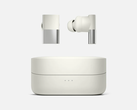Huawei FreeBuds SE TWS review: Wireless in-ear headphones with IP certification at a budget price
The Huawei FreeBuds SE position themselves in the entry-level segment with their RRP of just 50 euros, below the FreeBuds 5i (RRP: 100 euros). However, the inexpensive Huawei TWS only support a very limited selection of audio codecs and do without the active noise cancellation (ANC) of the sister model.
Thanks to the 10 mm dynamic drivers and an ultra-sensitive polymer diaphragm, the FreeBuds SE are nevertheless supposed to convince with a "crystal-clear sound". We will find out whether we really like the sound of Huawei's TWS and whether it is worth buying in this review.
Specifications
| Wearable | In-ear headphones |
| Connectivity | Bluetooth 5.2 |
| Speakers | 10 mm driver, Dynamic |
| Audio Codecs | SBC, AAC |
| Water resistance | IPX4 (earphones) |
| Noise cancellation | no |
| Charging port | USB-C |
| Wireless charging | no |
| Battery capacity | 37 mAh (earphones), 410 mAh (charging case) |
| Weight (earphones/case) | 5.1 g / 35.6 g |
| Microphones | 2 microphones per earphone |
| Scope of delivery | Charging case, earbuds (in sizes S,M and L), HUAWEI Music Premium card, USB-C charging cable |
| Price (MSRP) | 49.99 euros |
Case and ergonomics - Huawei FreeBuds SE with IP rating
The color selection of the FreeBuds SE is limited to a green-bluish and a white version of the Huawei TWS. The design is relatively susceptible to fingerprints due to the high-gloss finish. Together with the headphones, the charging case only weighs about 36 g, which is very light. Thus, the case lacks a bit of value, and the plastic used also feels less valuable than premium TWS - the same applies to the headphones themselves. On the other hand, the workmanship is very solid, and the case is closed securely with magnets. The lid of our test sample has some play and therefore wobbles a bit.
We found the FreeBuds SE comfortable to wear, and the in-ears also hold well enough for normal everyday use. Huawei calls the design of the in-ears Half-in-Ear-Design, which means that the headphones are inserted into the external ear canal. Three different silicone attachments allow individual adjustment for the best possible fit. In everyday use, Huawei's headphones do not stand out negatively due to their low weight of about 5 grams, even during longer use.
The IPX4-certified Huawei headphones promise sufficient protection against splashing water, but not against dust or water penetration. The Huawei FreeBuds SE are not suitable for users who like to clean their in-ears from sweat under running water after sports. The charging case does not offer protection against liquids.
Equipment and operation - Huawei headphones with G-sensor
Since the FreeBuds SE are rather in the low-priced TWS mid-range category the equipment features are rather manageable. Active noise cancellation or Transparent Hearing, like the Huawei FreeBuds Pro 2, is not supported by the SE model. However, each headphone has two silicone microphones that can filter out annoying frequencies during calls.
Google Fast Pair is not supported by FreeBuds SE, and the setup with an Android smartphone has to be done "classically" - via the pairing button inside the case; the same applies to Apple phones by the way. It is easier with a Huawei smartphone, as long as at least EMUI 10 or Harmony OS 2.0 is installed. In this case, the FreeBuds SE is paired directly when the case is opened.
The manufacturer's AI Life app is required for software updates or settings. The QR code on the packaging can be scanned on iOS and Android devices, while a Huawei phone downloads the app via HUAWEI's AppGallery. However, the settings of the FreeBuds SE are not extensive. Users will not look for more than an adjustment of the gesture control. And the gesture control is also a bit too small compared to other TWS headphones and very limited. Huawei's in-ears have touch-sensitive outer sides - Huawei calls this G-Sensor - but they only support a tap gesture. Here, the user can decide between pausing playback or accepting a call. We would have wished for more touch or tap gestures here.
Playback is automatically paused when removing the Huawei TWS from the ear canal. This wear detection, which automatically stops both music and movie playback, works very reliably in the FreeBuds SE in everyday use.
Voice quality - Huawei FreeBuds SE with background noise
We also used the FreeBuds SE as a headset to test the qualities during calls. The two microphones of each earpiece provide decent voice output during our calls, and our call partners attest to the Huawei headphones' clean reproduction in quiet surroundings. The FreeBuds SE are not very susceptible to wind noise.
Besides voice transmission, microphones are also supposed to reduce ambient noise - but this does not work as well in everyday use. The background acoustics are very present in Huawei's TWS. Our interlocutors perceive the street noise and the chirping of birds very well. We understand our counterpart very well, but the voices feel distant and slightly reverberated.
Sound - Huawei FreeBuds SE with 10 mm dynamic driver
The FreeBuds SE use 10 mm dynamic drivers with a polymer diaphragm for audio playback and cover a frequency range of 10 Hz to 20 kHz, according to the manufacturer. Besides the Bluetooth codec AAC, only the compulsorily supported SBC via Bluetooth 5.2 is available for use. Huawei does not report any latency for the FreeBuds SE in the spec sheet but we did not notice a significant offset between the picture and sound in YouTube videos or movies - we used Galaxy S23 Ultra or Galaxy Tab S8 Plus, and not a Huawei smartphone.
The most important feature of a pair of headphones, especially in light of the FreeBuds SE's lack of ANC, is the sound quality. The half-in-ear design makes the headphones sit securely in the ear, but the passive shielding of the in-ears is not very pronounced, which means that ambient noise is not really muffled either. This is especially evident since the silicone attachments are not flush with the casing and do not provide the necessary strength, and they often overlap when the TWS are removed.
The frequency spectrum is not as wide as in the FreeBuds 5i, but the FreeBuds SE's harmonic distortions are just as exemplary low in our measurements. The Huawei headphones offer a solid sound experience with a clear focus in the mid-range that brings some boredom and randomness overall. The 10-millimeter drivers do not have much power and deliver a rather flat sound image with little present bass. The clarity in the trebles is also not a strength of the FreeBuds SE. If the music playback is rich in bass and characterized by trebles, we find other TWS in this price range, like the OnePlus Buds Z2, to be fuller. The Huawei in-ears lack an equalizer or at least sound tuning profiles to compensate for these shortcomings.
| Loudspeakers | |
| THD | |
| Samsung Galaxy Buds2 Pro (RMS: -3.0 dBFS) | |
| Huawei FreeBuds SE | |
| Huawei FreeBuds 5i (RMS: -2.4 dBFS) | |
| THD+N | |
| Samsung Galaxy Buds2 Pro (RMS: -3.0 dBFS) | |
| Huawei FreeBuds 5i (RMS: -2.4 dBFS) | |
| Huawei FreeBuds SE | |
* ... smaller is better
THD (Total Harmonic Distortion): Harmonic distortion quantifies the magnitude of the components that arise due to non-linear distortion (harmonic content) in relation to the original signal. THD only refers to the fundamental component. The distortion factor is also often mentioned but refers to the total signal.
THD+N (Total Harmonic Distortion + Noise): This value is comparable to THD, but in addition to the harmonic distortion, that of the noise is measured as an RMS value.
For the measurement, a low-harmonic sinusoidal signal (1 kHz, > 0 dB) is reproduced via the headphones to be tested, which is recorded by a linear measurement microphone (measurement distance: approx. 1 cm) in an artificial head.
Both values are given as a percentage. The lower the value, the better the signal fidelity.
Huawei FreeBuds SE audio analysis
(+) | speakers can play relatively loud (92.4 dB)
Bass 100 - 315 Hz
(-) | nearly no bass - on average 18.6% lower than median
(+) | bass is linear (3.2% delta to prev. frequency)
Mids 400 - 2000 Hz
(±) | higher mids - on average 10.1% higher than median
(±) | linearity of mids is average (7.8% delta to prev. frequency)
Highs 2 - 16 kHz
(±) | higher highs - on average 9.9% higher than median
(+) | highs are linear (6.8% delta to prev. frequency)
Overall 100 - 16.000 Hz
(±) | linearity of overall sound is average (23.8% difference to median)
Compared to same class
» 70% of all tested devices in this class were better, 6% similar, 23% worse
» The best had a delta of 4%, average was 24%, worst was 134%
Compared to all devices tested
» 70% of all tested devices were better, 6% similar, 23% worse
» The best had a delta of 4%, average was 24%, worst was 134%
Huawei FreeBuds 5i audio analysis
(+) | speakers can play relatively loud (96 dB)
Bass 100 - 315 Hz
(-) | nearly no bass - on average 15.1% lower than median
(+) | bass is linear (3% delta to prev. frequency)
Mids 400 - 2000 Hz
(±) | higher mids - on average 6.2% higher than median
(+) | mids are linear (4.9% delta to prev. frequency)
Highs 2 - 16 kHz
(±) | higher highs - on average 10.5% higher than median
(+) | highs are linear (6.1% delta to prev. frequency)
Overall 100 - 16.000 Hz
(±) | linearity of overall sound is average (17.8% difference to median)
Compared to same class
» 35% of all tested devices in this class were better, 8% similar, 57% worse
» The best had a delta of 4%, average was 24%, worst was 134%
Compared to all devices tested
» 35% of all tested devices were better, 8% similar, 57% worse
» The best had a delta of 4%, average was 24%, worst was 134%
Battery runtimes - Huawei headphones with endurance
The FreeBuds SE each have a 37 mAh battery. According to the manufacturer, the TWS offer a battery life of up to 24 hours when using the included charging case. Without this supply station, a playback of up to 6 hours should be possible with the in-ears.
We performed our headphone battery test at an adjusted volume of 65 dB(A) with the AAC codec active. With a runtime of 359 minutes, we virtually achieved a precision landing on Huawei's specifications.
The headphones' charging case, which can be charged via the USB-C port but not wirelessly, has a capacity of 410 mAh and indicates the battery's charge status with a color of an LED indicator. The in-ears are charged in about 1.5 hours, and it takes about 120 minutes until the charging case has a battery capacity of 100% again when it is empty.
| Battery Runtime - Spotify loop at 65dB/A (incl ANC) | |
| Samsung Galaxy Buds2 Pro | |
| Huawei FreeBuds SE | |
| Huawei FreeBuds 5i | |
Verdict on Huawei FreeBuds SE TWS
The Huawei FreeBuds SE are very low-noise in-ear headphones with a good runtime but also some shortcomings. The low pricing of the TWS can certainly compensate for the lack of features like ANC or spatial audio, but the FreeBuds SE's basic features are too rudimentary for headphones. The operating concept and the sound, in particular, could have used a bit more fine-tuning. Those who enjoy bass-rich music will certainly not be convinced by the Huawei TWS.
Those who do not want to spend a lot of money on wireless headphones and use a Huawei device will find a cheap companion for the on-the-go in the FreeBuds SE. However, a sound miracle in the TWS mid-range should not be expected.
We see a suitable alternative in Huawei's cosmos with the FreeBuds 5i. A more extensive feature set, better sound, and above all solid ANC are offered for a price of well under 100 Euros. However, the same is also true for headphones from other manufacturers like the OnePlus Buds Z2, or Nokia Clarity Earbuds+ where a small surcharge entails much less willingness to compromise than in the FreeBuds SE.
Price and availability
The Huawei FreeBuds SE TWS are available for an MSRP of 50 Euros, among others at Amazon or the Huawei Store.
Transparency
The selection of devices to be reviewed is made by our editorial team. The test sample was provided to the author as a loan by the manufacturer or retailer for the purpose of this review. The lender had no influence on this review, nor did the manufacturer receive a copy of this review before publication. There was no obligation to publish this review. As an independent media company, Notebookcheck is not subjected to the authority of manufacturers, retailers or publishers.
This is how Notebookcheck is testing
Every year, Notebookcheck independently reviews hundreds of laptops and smartphones using standardized procedures to ensure that all results are comparable. We have continuously developed our test methods for around 20 years and set industry standards in the process. In our test labs, high-quality measuring equipment is utilized by experienced technicians and editors. These tests involve a multi-stage validation process. Our complex rating system is based on hundreds of well-founded measurements and benchmarks, which maintains objectivity. Further information on our test methods can be found here.




